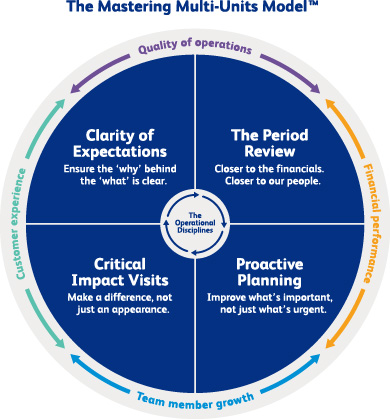
The operational disciplines lie at the heart of being a successful multi-unit manager. To achieve operational excellence, it’s vital to go beyond simply adhering to upholding brand standards.
This is the reason why we formulated our The Mastering Multi-Units Model™ a decade ago; and why we’ve recently given it a bit of a refresh! The model integrates two key components: operational disciplines and operational lenses.

The four operational disciplines are:
1. Clarity of expectations: this includes brand standards and ways of working, continuous review and improvement, and accountability for resolution.
2. The period review: covering analysis and commentary by the manager, mitigating issues and exploiting opportunities, and manager and team growth/succession.
3. Proactive planning: focusing on quantifiable priorities, identifying high-leverage activities and going beyond SMART objectives.
4. Critical impact visits: involving a review of action plan implementation, asking better questions and creating a culture of exceptional service.
All four are the practices that multi-unit managers need to master to achieve excellence. But, beware! They are not to be viewed as a buffet; we can’t pick and choose which ones we like, when we like. Instead, they must be seen as interdependent and integral to achieving consistently great results.
You can see from the model, that they also require us to ‘see’ our business through different lenses. In practice this means the multi-unit manager and the unit manager looking at the operation together through four operational lenses:
1. Quality of operations: brand standards being met, health and food safety requirements maintained, maintenance and marketing initiatives; essentially are we delivering on the brand promise?
2. Customer experience: feedback, mystery customer surveys, observation of the “moments of truth” that customers have during their time with the brand, who served them and what did they do well (for recognition) or what needs improvement?
3. Team member growth: to be fair, this concerns the team’s wider experience, not just their ongoing development. From recruitment to induction, the efforts made to recognise and reward colleagues; all aspects of an employee’s experience should be considered.
4. Financial performance: compared to last year, budget and/or targets, focusing on both metrics and other subjective, yet key areas of performance. This comes last not because it’s the least important, but due to the prevalence of the first three lenses in delivering great financial results.
While not every month demands attention to all four lenses, a quarterly action plan should encompass each lens over a four-quarter period.
Putting action plans into place, recognising successes, and redirecting performance, based on all the lenses ensures we develop a balanced operation. Consistently applying these practices is integral to attaining operational excellence.


